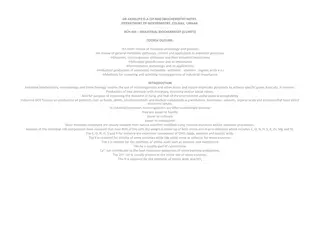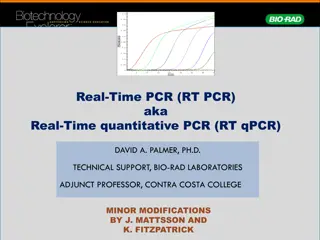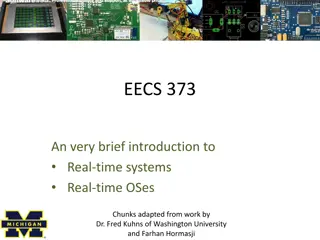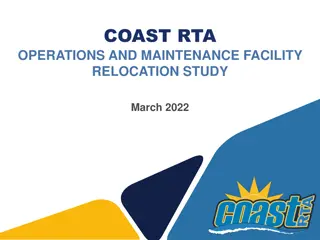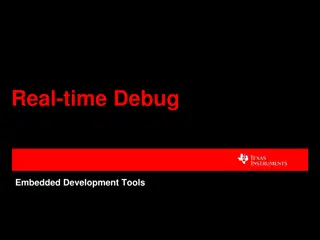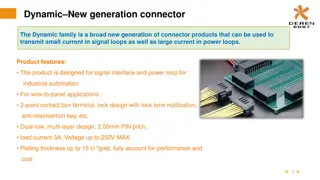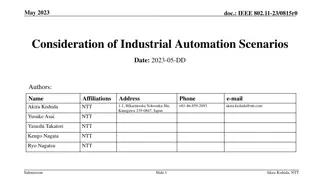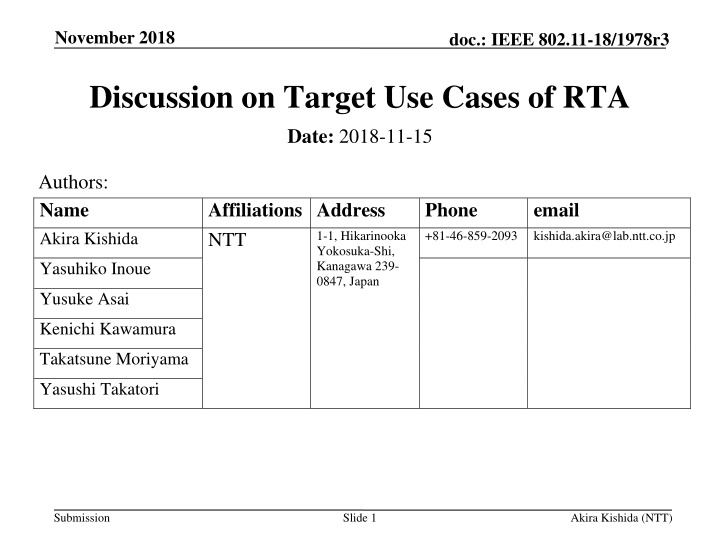
Key Use Cases of Real-Time Applications (RTA) for Industrial Business
This presentation discusses the key use cases of Real-Time Applications (RTA) for industrial business, focusing on haptic technology, drone control, real-time gaming, robotics, and industrial automation. The presentation highlights the requirements for stability, data rate, low latency, and packet loss in various scenarios, emphasizing the need for high stability in cases requiring low data rates and the importance of both low latency and high data rates in applications like VR and real-time gaming. Key technologies like haptic technology and drone control are explored in the context of Wi-Fi systems for different industries.
Download Presentation

Please find below an Image/Link to download the presentation.
The content on the website is provided AS IS for your information and personal use only. It may not be sold, licensed, or shared on other websites without obtaining consent from the author. If you encounter any issues during the download, it is possible that the publisher has removed the file from their server.
You are allowed to download the files provided on this website for personal or commercial use, subject to the condition that they are used lawfully. All files are the property of their respective owners.
The content on the website is provided AS IS for your information and personal use only. It may not be sold, licensed, or shared on other websites without obtaining consent from the author.
E N D
Presentation Transcript
November 2018 doc.: IEEE 802.11-18/1978r3 Discussion on Target Use Cases of RTA Date: 2018-11-15 Authors: Name Akira Kishida Affiliations Address NTT Phone email 1-1, Hikarinooka Yokosuka-Shi, Kanagawa 239- 0847, Japan +81-46-859-2093 kishida.akira@lab.ntt.co.jp Yasuhiko Inoue Yusuke Asai Kenichi Kawamura Takatsune Moriyama Yasushi Takatori Submission Slide 1 Akira Kishida (NTT)
November 2018 doc.: IEEE 802.11-18/1978r3 Abstract This presentation introduces key use cases of RTA for industrial business. Haptic technology, drone control In these use cases, high stability is required while required data rate is low. In case of pushing rich contents such as video streaming, high data rate is required. We also discuss use cases that require both low latency and high data rate such as VR. Some of real time gaming would be rich contents in the near future. We should decide whether high data rate RTA (Real Time Applications) should be included in the scope of RTA TIG or not. Submission Slide 2 Akira Kishida (NTT)
November 2018 doc.: IEEE 802.11-18/1978r3 Additional use cases for RTA Real-time gaming, robotics and industrial automation are the targets as use cases of RTA so far [1]. These use cases require low data rate. Requirements concerning stability such as jitter and packet loss are important for these use cases. We introduce some additional use cases to robotics and industrial automation. Haptic technology Drone control Guaranteed communication might be promising in Wi-Fi systems and will be demanded. Submission Slide 3 Akira Kishida (NTT)
November 2018 doc.: IEEE 802.11-18/1978r3 Haptic technology Haptic technology recreates the sense of touch by applying forces, vibrations, or motions to the user. If we can replace wired connection from devices to the server, flexibility of application would be expanded. Low latency, jitter, packet loss will be required. At least < 5ms latency should be demanded [2]. Submission Slide 4 Akira Kishida (NTT)
November 2018 doc.: IEEE 802.11-18/1978r3 Drone control Manufacturing and industry Steamlines inspection, management. Alternates high-place work. Logistics Wi-Fi would be utilized within limited site like warehouse. (Utilized in short range) Security Drones equip a camera and take photos and/or videos. Drone is a key device for several businesses. Manufacturing, industry, logistics, security, agriculture and entertainment for example. Wi-Fi would be suitable wireless system for drone if either of the following requirements is achieved. Low data rate enough for control signals with low latency and jitter. High data rate with sufficient capacity for video streaming. Submission Slide 5 Akira Kishida (NTT)
November 2018 doc.: IEEE 802.11-18/1978r3 Requirements of the additional use cases Use cases Latency Jitter Packet loss Data rate < 1 ms ~ 5 ms < 0.2 ~ 2 ms Loss less required < 1 Mbps Robotics and industrial automation Haptic technology < 100 ms < 10 ms Loss less required < 1 Mbps > 100 Mbps (with video streaming) Drone control *Detailed numbers of the requirements are further investigation. Requirements of data rate are low for control signals. However, required data rate would be high if these cases require rich contents such as video streaming. If 4K/8K video streaming is utilized, data rates of Gbps might be required. Not best effort , but guaranteed communication is required. Submission Slide 6 Akira Kishida (NTT)
November 2018 doc.: IEEE 802.11-18/1978r3 Requirements of use cases on the RTA TIG s report [1] Use cases Latency Jitter* [4] Packet loss Data rate < 10 ms < 5 ms < 0.1 % < 1 Mbps Real-time gaming [1] < 1 ms ~ 10 ms < 0.2 ~ 2 ms Near-loss less < 1 Mbps Robotics and industrial automation [3] Equipment control > 10 s ms > 1 ms Near-loss less < 1 Mbps Quality supervision > 100 ms > 20 ms Varies < 1 Mbps Factory resource management > 100 ms > 20 ms Varies Display < 10 s Mbps < 1 ms ~ 10 ms < 0.2 ~ 2 ms Near-loss less < 1 Mbps Human safety *Jitter values are calculated from [3] Requirements of data rate are low as well. According to [4], most industrial automations require loss less (BLER of 10-7 % to 10-5 %). Submission Slide 7 Akira Kishida (NTT)
November 2018 doc.: IEEE 802.11-18/1978r3 Real-time gaming in the future According to the Report of RTA TIG, requirements of data rate is very low because only control signals are considered. The communication bandwidth a console and a controller (a user equipment device) will be rich such as wireless VR application in the real-time gaming in the future. Approximately 5 Gbps will be required for VR (8K, 90+FPS, HDR, 6 Depth of Field video or free-viewpoint) [2]. Submission Slide 8 Akira Kishida (NTT)
November 2018 doc.: IEEE 802.11-18/1978r3 Requirements of VR, 4K/8K video [5] Use cases Latency Jitter Packet loss Data rate <10 ms (not mentioned) > 500 Mbps VR Partial immersion < 5 ms > 1000 Mbps Deep immersion < 20 ms < 20 ms 3e-7 > 100 Mbps Video 4K (Compressed) < 20 ms < 20 ms 3e-7 > 200 Mbps 8K (Compressed) Required data rates are very high. Wireless VR is the one of the target use case of EHT SG. Development of PHY layer technologies will be demanded. Submission Slide 9 Akira Kishida (NTT)
November 2018 doc.: IEEE 802.11-18/1978r3 Wireless VR in EHT [5] According to the John Son s contribution [6], latency characteristics of VR contents streaming under various configurations are investigated in EHT SG. The wireless VR was discussed as one of the main use cases for EHT [5][7][8] In July meeting, the motion for EHT SG formation was passed as follows: [9] Approve formation of the 802.11 Extremely High Throughput (EHT) Study Group to consider development of a Project Authorization Request (PAR) and a Criteria for Standards Development (CSD) responses for a new 802.11 amendment for operating in the bands between 1 and 7.125 GHz, with the primary objectives: To increase peak throughput and improve efficiency To support high throughput and low latency applications such as video-over- WLAN, gaming, AR and VR Submission Slide 10 Akira Kishida (NTT)
November 2018 doc.: IEEE 802.11-18/1978r3 Discussions RTA missions Investigate latency and stability issues observed with real time applications such as mobile and multiplayer games, robotics and industrial automation. Potential mechanisms to address the identified issues. Use cases that require both low latency and high data rate Some of industrial automation and robotic that push rich contents. Wireless VR. Future real-time gaming that requires heavy data traffic. Should we include those use cases or not? If it is yes, joining EHT SG is one of the options. If it is no, we should focus on the development of MAC layer and upper solutions, not in PHY layer. Submission Slide 11 Akira Kishida (NTT)
November 2018 doc.: IEEE 802.11-18/1978r3 Conclusions Two additional use cases are introduced. Haptic technology, drone control . In these use cases, high stability is required while required data rate is low. In case of pushing rich contents such as video streaming, high data rate is required. We should decide whether high data rate RTA (Real Time Applications) should be included in the scope of RTA TIG or not. Wireless VR (discussions are in progress in EHT SG). Future real-time gaming that requires high data rate. Submission Slide 12 Akira Kishida (NTT)
November 2018 doc.: IEEE 802.11-18/1978r3 Straw Poll #1 Do you think that applications that require both low latency and high data rate such as VR should be included in the scope of RTA TIG? Y: 14 N:8 A:1 Need more further investigations:1 Submission Slide 13 Akira Kishida (NTT)
November 2018 doc.: IEEE 802.11-18/1978r3 Straw Poll #2 How should we continue our future activity? RTA should: (a) Be a separate SG and amendment and target at both PHY and MAC layer technologies. (b) Be a separate SG and amendment and target at only MAC layer technologies and upper layer solutions. (c) Be a part of the EHT and follow-on activities and amendment or self cancellation. (d) Continue discussions and not make a decision at this time. (a):3 (b):6 (c):3 (d):17 Other:1 Submission Slide 14 Akira Kishida (NTT)
November 2018 doc.: IEEE 802.11-18/1978r3 References [1] Kate Meng, RTA report discussion, IEEE 802.11-18-1690r0 [2] Qualcomm Technologies, Inc., VR and AR pushing connectivity limits, https://www.qualcomm.com/media/documents/files/vr-and-ar-pushing-connectivity-limits.pdf [3] Zein Nader, et al., Wired/Wireless Use Cases and Communication Requirements for Flexible Factories IoT Bridged Network, Nendica Draft Report 802.1-18-0025-06-Icne [4] Richard Candell, Reliable, High Performance Wireless System for Factory Automation, IEEE 802.11-18/1784r0 [5] David Xin Yang, et al., Next Generation PHY/MAC in Sub-7GHz, IEEE 802.11-18-0846r2 [6] Jon Son, et al., Experiments on Wireless VR for EHT, IEEE 802.11-18- 1606r0 [7] Laurent Carou, et al., EXtreme Throughput (XT) 802.11, IEEE 802.11-18- 0789r10 [8] Dave Cavalcanti, et al., Controling latency in 802.11, IEEE 802.11-18/1160r0 [9] Ron Porat, et al., EHT SG formation Motion, IEEE 802.11-18-1263r3 Submission Slide 15 Akira Kishida (NTT)


